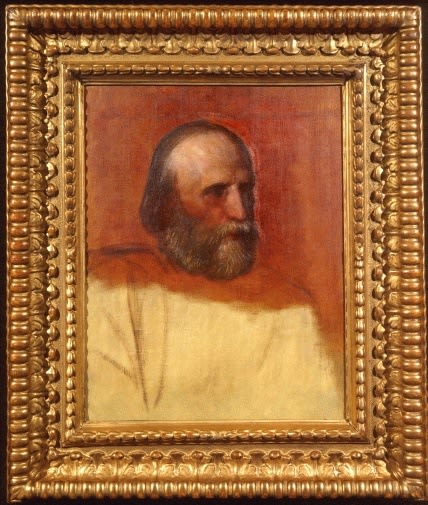
George Frederic Watts OM, RA
Portrait of Giuseppe Garibaldi (1802-82), 1864
Oil on canvas
28 1/2 x 21 in. (72.4 x 53.3 cm)
Philip Mould & Co.
To view all current artworks for sale visit philipmould.com The combination of painter and sitter in this painting produces a potent image. Watts is well-known not only as an...
To view all current artworks for sale visit philipmould.com
The combination of painter and sitter in this painting produces a potent image. Watts is well-known not only as an inspired sculptor and painter of allegory, but principally as the most accomplished portraitist of Victorian England whose works formed the core of the National Portrait Gallery after its foundation in 1856. Giuseppe Garibaldi was, at the time of this sitting in spring 1864, on a celebratory tour of England, feted as the unifier of his country and an intriguing new political force on the Continent.
The sitting, at Little Holland House, that produced this painting -as a preparatory study for a further portrait- is well-documented:
''Two portraits were attempted during some few early hours (6 and 7a.m.), the old Duchess of Sutherland reading meanwhile to Garibaldi and Mr Watts. The first a realistic study of the head only, in the second something of a mystery envelops the head of the hero.''1
A later-published account by the same writer supplies further detail:
''Signor [the term by which Mrs Watts habitually refers to her husband in this volume] as a true sympathiser with the emancipation of Italy, who admired him greatly had arranged with the Duchess of Sutherland to attempt to make a portrait of him, but the sittings had to be from seven until eight in the morning, and even then there were deputations waiting below to pay him homage. The Duchess came herself and read aloud to the patient sitter.''2
Our portrait is the first of these paintings. The larger second canvas, in which, certainly, the aspect of the sitter is given a more tenebrous cast, and in which the body of the subject is suggested to a greater degree, is in the keeping of the Watts Museum, Compton. Neither version was destined to return with Garibaldi to Italy -the commission was made for English patrons- but a photograph of the larger portrait was later sent to Garibaldi's son, who declared that it was an excellent likeness.
(1) Mary Watts Catalogue of the Works of G.F. Watts compiled by his widow, Vol. II, p. 57.
(2) Mary Watts George Frederic Watts Volume I Annals of an Artist's Life. P. 220. Macmillan (1912).
The combination of painter and sitter in this painting produces a potent image. Watts is well-known not only as an inspired sculptor and painter of allegory, but principally as the most accomplished portraitist of Victorian England whose works formed the core of the National Portrait Gallery after its foundation in 1856. Giuseppe Garibaldi was, at the time of this sitting in spring 1864, on a celebratory tour of England, feted as the unifier of his country and an intriguing new political force on the Continent.
The sitting, at Little Holland House, that produced this painting -as a preparatory study for a further portrait- is well-documented:
''Two portraits were attempted during some few early hours (6 and 7a.m.), the old Duchess of Sutherland reading meanwhile to Garibaldi and Mr Watts. The first a realistic study of the head only, in the second something of a mystery envelops the head of the hero.''1
A later-published account by the same writer supplies further detail:
''Signor [the term by which Mrs Watts habitually refers to her husband in this volume] as a true sympathiser with the emancipation of Italy, who admired him greatly had arranged with the Duchess of Sutherland to attempt to make a portrait of him, but the sittings had to be from seven until eight in the morning, and even then there were deputations waiting below to pay him homage. The Duchess came herself and read aloud to the patient sitter.''2
Our portrait is the first of these paintings. The larger second canvas, in which, certainly, the aspect of the sitter is given a more tenebrous cast, and in which the body of the subject is suggested to a greater degree, is in the keeping of the Watts Museum, Compton. Neither version was destined to return with Garibaldi to Italy -the commission was made for English patrons- but a photograph of the larger portrait was later sent to Garibaldi's son, who declared that it was an excellent likeness.
(1) Mary Watts Catalogue of the Works of G.F. Watts compiled by his widow, Vol. II, p. 57.
(2) Mary Watts George Frederic Watts Volume I Annals of an Artist's Life. P. 220. Macmillan (1912).
Provenance
The artist's studio contents;Bequest to the Lilian Mackintosh, Mrs Michael Chapman (d.1972);
Family Descent
Literature
Mary Watts Catalogue of the Works of G.F. Watts compiled by his widow, Vol.II, p.57Mary Watts George Frederic Watts Volume I Annals of an Artist''s Life. p220. Macmillan (1912).
Be the first to hear about our available artworks
* denotes required fields
We will process the personal data you have supplied in accordance with our privacy policy (available on request). You can unsubscribe or change your preferences at any time by clicking the link in our emails.